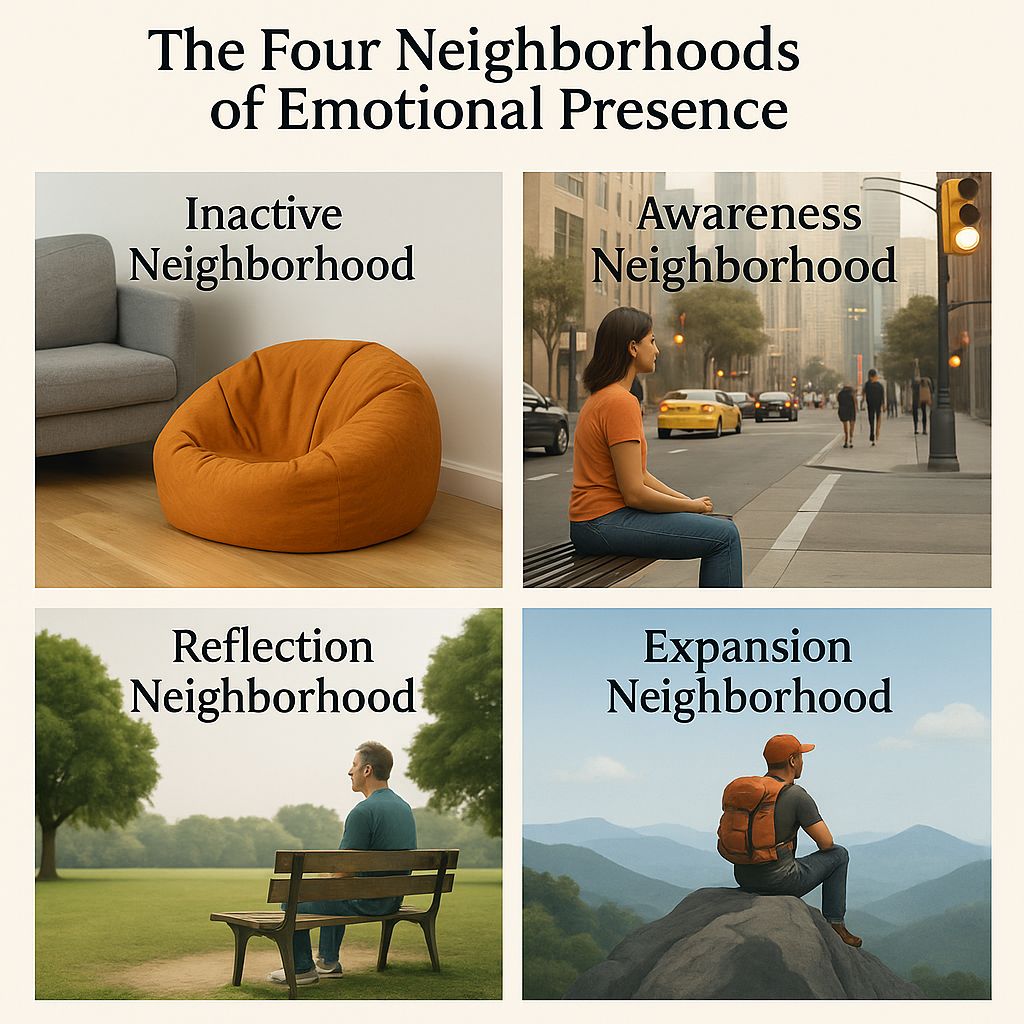
Meet CJ (Chair of JOY), who lives in a world where the four emotional stages of presence aren’t complicated theory – CJ simply calls them neighborhoods to navigate emotions faster. CJ has learned to travel between these neighborhoods consciously, and now shares that map with you.
CJ’s Discovery
CJ discovered something life-changing: the four emotional stages of presence operate like neighborhoods CJ visits throughout each day. CJ moves between all four regularly, sometimes within minutes of each other. None are bad – each serves a purpose. Some are quiet, some restless, some peaceful, some alive with energy. CJ learned the key is noticing which neighborhood CJ is visiting and understanding the bridges that connect them.
The Four Neighborhoods Where CJ Lives
CJ moves between these neighborhoods naturally, crossing bridges quickly or slowly, back and forth, often during the day. But here’s what CJ loves most: the bridges themselves.
Inactive Neighborhood – Where CJ Rests What CJ experiences: Quiet streets, gray skies, windy corners, the occasional thunderstorm. Why CJ visits: CJ’s system conserves energy here. Stress, anxiety, or withdrawal settle in. What CJ values: This neighborhood offers pause and rest, serving different purposes at different times. CJ’s Chair of JOY here: Like sinking into a soft beanbag – CJ rests until ready to rise.
Awareness Neighborhood – Where CJ Notices What CJ experiences: Busy sidewalks, honking traffic, bright lights, constant activity. Why CJ visits: CJ notices emotions clearly here – insecurity, overwhelm, doubt – but wrestles with them. What CJ values: This neighborhood wakes CJ up to what’s happening. CJ’s Chair of JOY here: Like a subway seat – awake and alert, processing all the motion.
Reflection Neighborhood – Where CJ Thinks What CJ experiences: A park with open skies, shaded benches, room to breathe. Why CJ visits: Hope, resilience, calm, and gratitude settle naturally when CJ is here. What CJ values: This is where CJ learns and problem-solves, where emotions become resources. CJ’s Chair of JOY here: A comfortable park bench for calm, clear thinking.


Expansion Neighborhood – Where CJ Thrives What CJ experiences: A vibrant marketplace filled with music, creativity, and connection. Why CJ visits: CJ feels confident, inspired, and in flow with others here. What CJ values: This is where CJ’s fullest potential emerges – leadership, creativity, and connection shine. CJ’s Chair of JOY here: A mountain top with wide views, energy expanding outward.
CJ’s Favorite Part: The Bridges
CJ loves spending time on the three bridges connecting these neighborhoods. CJ walks slowly on these bridges, takes time to listen, and feels what each crossing means:
The Accountability Bridge – CJ crosses this when ready to take ownership and move from feeling stuck to becoming aware.
The Acceptance Bridge – Where CJ practices accepting what is, allowing movement from wrestling with emotions to reflecting on them clearly.
The Trust Bridge – Where CJ practices trusting the process, crossing from reflection into full expansion and flow.
CJ’s Discovery
CJ discovered something life-changing: the four emotional stages of presence operate like neighborhoods CJ visits throughout each day. CJ moves between all four regularly, sometimes within minutes of each other. None are bad – each serves a purpose. Some are quiet, some restless, some peaceful, some alive with energy. CJ learned the key is noticing which neighborhood CJ is visiting and understanding the bridges that connect them.
Sometimes CJ needs to do several Chair of JOY practices on a bridge before crossing completely. CJ sits down, breathes, thinks, and feels what’s possible on the other side of the bridge and also may make a choice that staying put is also perfectly fine.
CJ’s Bridge Practice: From Overwhelm to Reflection
Imagine CJ feeling overwhelmed in the busy Awareness Neighborhood – honking traffic, bright lights, constant motion. CJ walks to the Acceptance Bridge and sits down right in the middle.
CJ breathes in slowly, then out, letting the busy neighborhood noise fade into background. CJ thinks about what waits on the other side: the Reflection Neighborhood with its open skies, park benches, and room to breathe clearly.
As CJ continues breathing, CJ feels something shift in the body – a loosening in the chest, a softening in the shoulders. CJ visualizes walking into that park space, sitting on the bench, having perspective on all that busyness instead of being caught inside it.
CJ imagines the potential: instead of wrestling with the overwhelm, simply observing it from the park bench. Seeing solutions instead of just problems. Feeling hope instead of just stress.
After several minutes of this Chair of JOY practice – sitting, breathing, thinking about the possibility, feeling the body’s capacity to move there – CJ stands up and walks across the bridge. The Reflection Neighborhood welcomes CJ with its calmer energy and clearer perspective.
CJ’s Invitation
CJ has learned that bridge time is sacred time. The crossing itself builds stronger navigation skills. Each Chair of JOY practice on a bridge strengthens CJ’s ability to move consciously between the four emotional stages of presence, using imagination and body awareness to feel into new possibilities before stepping into them.
Ready to join CJ on the bridges? The Chair of JOY is ready for you anytime: Simply sit, breathe, think about where you want to go, and feel that potential alive in your body.
Edwards, Phil. “7 World-Changing Inventions People Thought Were Dumb Fads.” Vox, 29 Jun 2015.
Basinger, Jeanine. “THE LAST WORD ON TALKIES – How Sound Changed Hollywood.” Washington Post, 16 Apr 1997.
Skarda, Erin. “Top 10 Failed Predictions – Technology? What’s That?” TIME, 21 Oct 2011.
Schmidt, Ann. “How Fred Smith Rescued FedEx from Bankruptcy.” Fox Business, 19 Jul 2020.
Entrepreneur Magazine. “And They Said it Couldn’t be Done,” 16 Oct 2008.
Broomfield, Benjamin. “‘Forced Joy’: Why Culture and Bonus Failures Led to Tiffany’s Staff Exodus.” HR Grapevine, 30 Jan 2025.
“Long-Term Support for Employee Stress and Burnout.” Uprise Health (citing HBR), 2022.
Whiting, Kate. “World Mental Health Day: Prioritize Well-Being at Work.” World Economic Forum, 4 Oct 2024.
World Health Organization. “Suicide.” WHO.int, 2023.
Mayo Clinic Staff. “Chronic stress puts your health at risk.” MayoClinic.org, 2021.
Abell, Paul. “365 Keys to Longevity.” 2024.
Schore, Allan N. Affect Regulation and the Origin of the Self: The Neurobiology of Emotional Development. Lawrence Erlbaum Associates, 1994.
JOYELY® transforms workplace culture with digital emotional processing tools and data-driven technology, empowering engaged, resilient, and high-performing teams. Dedicated to elevating global well-being, JOYELY® makes joy a core life skill through experiences like the Chair of JOY®, JOY Intelligence™ Emotions Map, and the Four Stages of Presence. Inspiring individuals and organizations to access clarity, resilience, and purpose, JOYELY® is available for conferences, keynotes, event showcases, interactive programs, and fundraising—creating an undeniable conversation for all.



Welcome to JOYELY, where JOYELY Ever After is not just a dream, it’s our lifestyle.
© 2025 JOYELY. All Rights Reserved.